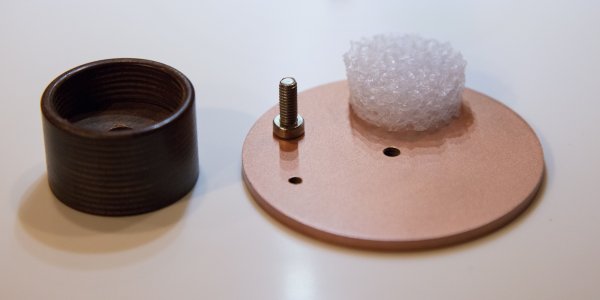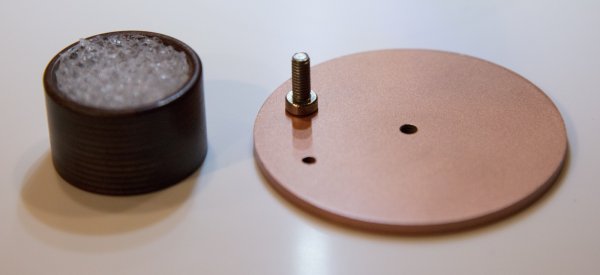Thinking purely hypothetically, a more adequate comparison would be Daiza vs Intro and Tana vs. Basic/Advanced.
Cheers,
Cheers,
Thinking purely hypothetically, a more adequate comparison would be Daiza vs Intro and Tana vs. Basic/Advanced.
Cheers,
Hi Bill,
I wouldn't like to interfere too much with this thread so let me just pass few remarks:
1) Experimenting with mixing different approaches/products is the idea I can only applaud!
2) I do not exactly agree that we are doing different things. Rather we are doing things differently and this is the beauty of a creative powerHeavy, constrained layer damped slate sandwiches we use are also great in component damping, serving as an inert "vibrations dissipator". Thus the comparison I mentioned would be valid in my view albeit what you propose is even better. In case of either solution, the main question is how to couple tightly to the platform to use its potential fully. If I'm permitted to describe our solution, we designed footers with a steel cup (low impedance coupling to the case) and a slate bottom (low impedance coupling to the platform) with a viscoelstic layer in between coupling the two. I also like a lot Stehno's idea of clamping components to platforms.
3) The comparison I suggested was rather based on the main building principle: Both Intro and Daiza (as far as I know) are rigid platforms, while of course Tana and Basic/Advanced are suspended.
Cheers,
Hi Jarek,
I don’t speak for Taiko obviously so maybe Emile will chip in. I personally don’t think it is a case of either / or in this instance. The aim of the Daiza is removing vibration inside the component rather than blocking it getting in. As such I would see the Daiza as a worthy product *in combination* with your products - I don’t see them competing as they are doing different things.
Best.
I just re read this thread. I didn't read most comments here before...only looked at pics of the French system and teased him because I never found noticable improvement with this kind of product at the same time not robbing something away from my system. I am still in the process of finding the best way to use Daiza in my system. But I would say what Blue described above is very much resemble what I am experiencing...especially the bang for the buck part.I promised a few comments on the full Daiza complement in my system and I’m happy to report that the sound quality uptick has been both revealing and great value for money. In fact I have sold most of my old isolation products to help pay for one of the Daiza and don’t miss a single one of them. (the Daiza underneath my amplifiers are a special size to accommodate their large footprint and almost any size can be made to order.)
The level of transparency has increased and of course dynamics but the most startling effect for me is the ability to play loud with no discernible distortion. I’m talking about those vocal crescendos that often break up or become harsh or big bombastic orchestral scores that used to sound congested when the volume increased. Somehow the Daiza are breaking the feedback loop between speakers and components more effectively than anything else I’ve tried. The Daiza feet under the Aqua also improved the sound by tightening up the bass creating greater propulsion to the music.
Emile has created something special here and I thank him for bringing these platforms to market.
Cheers
Blue58
I just took delivery of a Plixir Elite BAC 3000 pre-conditioner weighing about 40kg. I intend to get a daiza platform for it but want to first replace the stock bFly footers. Would something like the AmCan Isolators (spiked) work well with the Daiza? I also have a set of MIG 2.0 and Tiglon TMX4. Wondering which would be the best candidate for use with the Daiza.
The aim of the Daiza is removing vibration inside the component rather than blocking it getting in.
That is fascinating - the part about removing vibration [from] inside the component.
Speculation on my part:
I'm guessing that placing a piece of panzerholz board directly in contact with the component is more effective than siting the component's feet on the board? Is that the case? The acoustic impedance of wood is pretty low so the more wood in contact with the component's case (particularly an aluminum case) would yield greater energy transference from the case to the wood? Where does the energy in the wood go - or get turned into some other form of energy?
Spot on, using panzerholz as an interface works very well. It is absorbed by internal damping. It is about 4 times as effective as a block of rubber of the same size, yet it’s not compliant, does not act as a spring, so no “muddy” sound from the associated resonance peak. Panzerholz was designed to stop bullets, it is very efficient at dissipating “impact energy”.
Edit: a larger contact surface area with the equipment has a downside, as it will literally bounce up and down creating oscillations between the surfaces. In the end it’s still a balancing act.
there is a limit to the panzerholz's "capacity" ?
I just took delivery of a Plixir Elite BAC 3000 pre-conditioner weighing about 40kg. I intend to get a daiza platform for it but want to first replace the stock bFly footers. Would something like the AmCan Isolators (spiked) work well with the Daiza? I also have a set of MIG 2.0 and Tiglon TMX4. Wondering which would be the best candidate for use with the Daiza.


How is it to you with vs without foam filling the footers Mike.Emile sent me some 'raw' Daiza footers to try. 'raw' means without the copper interface attached meant for the Daiza cutouts underneath. so small; less than one inch panzerholtz rounds open on one end, and filled with plastic foam. i had some unused Daiza footers from where my Tana LPS units are using spikes on carpets, so i removed some of those copper rounds there too so i had enough.
i used these in place of the Stay HiFi Trina dual ball footers i had been using with the MSB power bases and the Extreme server to interface with the Daiza's. i also used them on the Tana TS-150 active shelves where i had used the BDR carbon fiber cones between the MSB dac and the darTZeel pre and the Daiza's sitting on top of the TS-150.
so now all my source electronics have a Daiza <-> Daiza footer interface only......top.......and bottom + 2 Tana TS-150 active shelves. the Daiza's are all only using panzerholtz to interface with my solid Adona granite shelves.
View attachment 58492
the first 2 hours was ultra detailed but a bit cold and harsh. went upstairs to watch some football, then came back and it was more natural sounding. the next morning better. by that night it was better than prior, and now 2 days later a nice step better than before. just overall more textured and cohesive, better flow. less processed and less a sense of reproduced music. not a tiny thing, not huge, but real and appreciated. like the A/C grid power got better and it's more relaxed and involving. my system already has exceptional sound staging and image separation. might that have improved? can't say....maybe.
my guess is that having a solid rack, then the three layers of panzerholtz interfaces seems to 'quiet' the gear synergistically. also.....Emile thought, and i tend to agree, that having the whole signal path on the same interface yields something positive. obviously the dac and pre have the TS-150 active so that's not the same right now.
the Daiza footer pictured below is used with the open end down. the closed end against the gear bottom.
View attachment 58493
How is it to you with vs without foam filling the footers Mike.
How is it to you with vs without foam filling the footers Mike.
Dear Tang,
don't know, have not tried it. my guess is that it's the foam that adjusts over time mostly. so the answer might be a bit sterile. but that's just a guess.
| Steve Williams Site Founder | Site Owner | Administrator | Ron Resnick Site Owner | Administrator | Julian (The Fixer) Website Build | Marketing Managersing |


